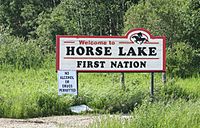Horse Lake First Nation facts for kids

Welcome sign
|
|
| People | Dane-zaa and Cree |
|---|---|
| Treaty | Treaty 8 |
| Headquarters | Horse Lakes |
| Province | Alberta |
| Land | |
| Main reserve | Horse Lakes 152B |
| Other reserve(s) | |
| Land area | 30.991 km2 |
| Population (2019) | |
| On reserve | 507 |
| Off reserve | 731 |
| Total population | 1238 |
| Government | |
| Chief | Ramona Horseman |
| Council |
Bruce Horseman, Cameron Horseman, Chantille Petroski, Dallas Ferguson
|
| Tribal Council | |
| Western Cree Tribal Council | |
| Website | |
| horselakefn.com | |
The Horse Lake First Nation is a group of Indigenous people in Canada. They live west of Hythe in northwestern Alberta. This First Nation includes people from both the Dane-zaa (also called "Beavers") and Cree cultures.
The Horse Lake First Nation is part of Treaty 8. This is an important agreement between Indigenous peoples and the Canadian government. They are also a member of the Western Cree Tribal Council. This council helps different Cree First Nations work together. Even though they are part of a Cree council, the Horse Lake First Nation has strong ties to the Dane-zaa language and traditions.
About the Horse Lake First Nation
The Horse Lake First Nation is a self-governing community. They work to manage their own affairs and protect their culture. Their main office is in Horse Lakes 152B. The current chief is Ramona Horseman. She works with a council to make decisions for the community.
Population and Land
As of 2019, the Horse Lake First Nation has 1,238 members. About 507 members live on their reserves. Another 731 members live in other places.
The First Nation has two main land areas, called reserves:
These reserves cover a total area of about 30.99 square kilometers (3,099.1 hectares). Reserves are special lands set aside for First Nations people.
Education for Students
Since 2002, students from the Horse Lake First Nation have attended schools in Alberta's public education system. They go to schools run by the Peace Wapiti School Division (PWSD). This means they learn alongside other students in the province.
The Canadian government, specifically Indigenous and Northern Affairs Canada, helps pay for the education of these students. This arrangement helps ensure that Horse Lake First Nation children get a good education.

